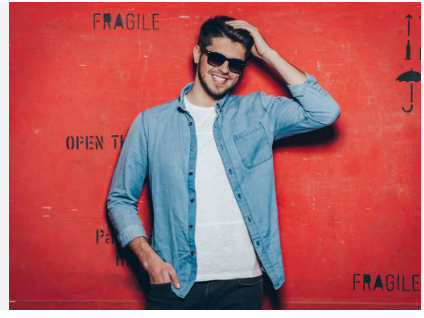Title: Y2K Style for Men & the Distribution Lawsuit: A Deep Dive into the Trend and Controversy

The early 2000s, also known as the Y2K style for men distinct fashion aesthetic that has made a massive comeback in recent years. Characterized by futuristic silhouettes, metallic fabrics, baggy jeans, and sporty sunglasses, Y2K style for men is now more popular than ever. But as the fashion world embraces nostalgia, a controversy is brewing—lawsuits surrounding distribution rights are shaking the industry.
In this article, we’ll dive into the Y2K men’s fashion revival, explore how distribution lawsuits are impacting the trend, and break down what it means for brands and consumers.
The Y2K Aesthetic for Men: What’s the Hype About?
A Look Back at the Original Y2K Fashion Scene
The Y2K aesthetic wasn’t just about clothing—it was a cultural statement. The late ‘90s and early 2000s saw the rise of boy bands, futuristic tech, and an overall obsession with the digital future. This translated into men’s fashion through oversized denim, neon windbreakers, and space-age accessories. Influences from hip-hop, streetwear, and European high fashion all blended into what we now call Y2K style.
Fashion icons like Justin Timberlake, Jay-Z, and Pharrell Williams were seen rocking the era’s biggest trends, from flashy velour tracksuits to baggy cargo pants and chunky sneakers. At the time, brands like FUBU, Sean John, and Ecko Unlimited dominated the scene, setting the standard for Y2K menswear.
Why is Y2K Style Making a Comeback?
Fashion operates in cycles, and the resurgence of Y2K style for men is proof of that. Gen Z, always on the lookout for unique and bold aesthetics, has rediscovered the era through social media platforms like TikTok and Instagram. Vintage shopping, sustainable fashion, and nostalgia-driven marketing have fueled the demand for retro-futuristic styles.
Additionally, major fashion houses and streetwear brands have capitalized on this trend. Designers like Balenciaga, Prada, and Louis Vuitton have reintroduced elements of early 2000s fashion in their recent collections, reinforcing the Y2K revival. But with this resurgence comes a legal storm that threatens the supply chain of these nostalgic pieces.
The Legal Battle: Understanding the Distribution Lawsuit
What is the Distribution Lawsuit About?
As the Y2K trend explodes, legal disputes over brand rights, trademarks, and distribution agreements have emerged. Many smaller brands and independent sellers rely on third-party distribution channels to sell their Y2K-inspired clothing. However, larger corporations are taking legal action, claiming unauthorized use of copyrighted designs and unauthorized distribution of branded merchandise.
The lawsuit in question revolves around whether certain brands have the right to resell vintage and reproduction Y2K pieces. Some companies argue that resellers are infringing on their intellectual property, while others claim that they are simply preserving fashion history by making these styles accessible.
Who Are the Key Players in the Lawsuit?
On one side, we have established brands that originally defined the Y2K aesthetic, such as Nike, Adidas, and Tommy Hilfiger. These companies are cracking down on unauthorized distribution, especially regarding vintage and deadstock items. On the other hand, independent designers, online resellers, and thrift store entrepreneurs are fighting for the right to sell these items freely.
Platforms like Depop, Grailed, and eBay have been caught in the crossfire, as they provide a marketplace for second-hand and reworked Y2K fashion. The lawsuit could impact how these platforms operate in the future, possibly leading to stricter regulations and limited availability of Y2K pieces.
How This Could Impact Consumers
If the lawsuit favors the major brands, we could see a decline in accessible Y2K men’s fashion. Prices for authentic vintage pieces may skyrocket, and independent sellers may struggle to operate. Conversely, if the lawsuit favors smaller resellers, it could set a precedent for the continued democratization of fashion, allowing consumers to explore Y2K style without corporate restrictions.
The Future of Y2K Fashion in the Wake of Legal Controversies
Will Y2K Fashion Survive the Legal Storm?
Despite legal battles, Y2K fashion is unlikely to fade anytime soon. The trend has firmly established itself in the mainstream, influencing both high fashion and streetwear brands. While lawsuits may cause temporary disruptions, they won’t erase consumer demand for these nostalgic styles.
If anything, the controversy has drawn more attention to Y2K fashion, making it even more desirable. Whether through DIY upcycling, underground fashion collectives, or shifts in production methods, Y2K menswear will continue to evolve despite legal challenges.
What Can Brands and Consumers Expect?
For brands, navigating the fine line between protecting intellectual property and adapting to fashion trends will be crucial. Some companies may start releasing their own Y2K-inspired collections to stay relevant, rather than relying solely on lawsuits to protect past designs.
For consumers, it’s important to stay informed about where and how Y2K fashion is sourced. Supporting ethical and legal distribution channels will ensure the sustainability of the trend without fueling legal disputes. Additionally, keeping an eye on second-hand markets and upcycled fashion can be a great way to enjoy Y2K aesthetics while avoiding legal complications.
Conclusion: The Intersection of Fashion, Nostalgia, and Law
The resurgence of Y2K fashion for men is a testament to the power of nostalgia and cultural cycles. However, as the trend gains momentum, the legal side of fashion distribution has come under scrutiny. While distribution lawsuits present challenges for resellers and independent designers, they also highlight the importance of intellectual property in the fashion industry.
Regardless of the outcome of these legal battles, Y2K fashion is here to stay. Whether through vintage pieces, brand-new designs, or legal reforms, the trend will continue to shape men’s fashion in the coming years. So, if you’re a fan of the early 2000s aesthetic, now is the time to embrace it—before legal restrictions make it harder to get your hands on those iconic Y2K pieces!
Also read Title: Understanding Different Types of Pants and Distribution Lawsuits





